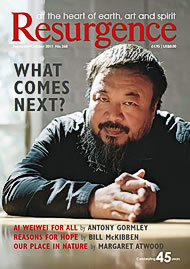John Stewart Allitt has been impeccably edited by his widow, the artist Eleanor Allitt, and this fascinating book gives a unique insight into the artist’s and the author’s deep concerns about our materialistic age – their prescience more relevant than ever for us today.
Allitt’s informed knowledge of Cecil Collins is the result of a long and mutually supportive friendship founded on a shared view of education, their profound belief in the sacred basis of the arts and life itself, their passion for music and poetry, and an understanding that the arts are important as a spiritual vehicle of communication.
The two men met at Central School of Art (now Central Saint Martins) in London, where Allitt taught art history and Collins life drawing. Allitt, fluent in both French and Italian, was an authority on the music of Donizetti and on Dante’s poetry. And Collins, as Allitt accurately observed, carried the mask of an English eccentric with grace, but was at heart a widely read European with erudite knowledge of not only English, but also European, Oriental and Asian art, poetry and philosophy.
It could be said that in spite of the difference in their temperaments, ages and cultural backgrounds, they were ‘true companions’ to each other. Indeed, Collins and his wife, Elisabeth, developed close ties with the whole Allitt family, and Collins was godfather to Allitt’s eldest daughter, Nicoletta.
The Magic Mirror (referring to the title of one of Collins’ finest paintings, as discussed in the book) is divided into six thematic chapters, which take as their point of departure the most important elements and symbols of Collins’ art. They comprise: The Visionary, The Theatre of the Soul, The Mystic Landscape, Illumination through the Feminine, The Purity of the Fool and The Angelic Intelligences.
The book is greatly enriched by a remarkable tale related by Collins, who, “like a wise Sufi”, preferred storytelling to argument. And personal recollections of conversations with the artist are amplified by Allitt’s perceptive observations about the sources and inspirations of Collins’ art.
Allitt comments that Collins was “like a master alchemist, [who] knew the inscape of the soul; furthermore, through his dedication to his vision, he was able to awaken the gift of seeing” in others through his art. And as a teacher, he “apprenticed his students as observers and even partakers of this inner theatre”.
According to Allitt, Goethe’s Faust, Dante’s Divine Comedy and a range of Hindu beliefs – as well as his relationship to his beloved Elisabeth – all informed Collins’ view of the feminine. And he believed the feminine initiates the masculine into higher states of consciousness.
Collins’ book The Vision of the Fool (1944) is quoted, and Allitt expounds the enigmatic qualities and significance of the Fool for Collins’ work, with reference to Buddhist and Islamic art, Platonic philosophy and Christian beliefs.
He suggests, too, that angels, who often appear in Collins’ art, “record his encounter with a mode of knowledge”. Collins believed “the painter of angels has to discover the angelic world within himself…it is always there…waiting to be seen with ‘the eye of the heart’”.
The 10 illustrations are carefully selected and informatively discussed in the text and include the previously unpublished cover image, a wedding gift from the artist to John and Eleanor Allitt. A brief biography of the artist is included, as well as two interesting Appendices about the author.







